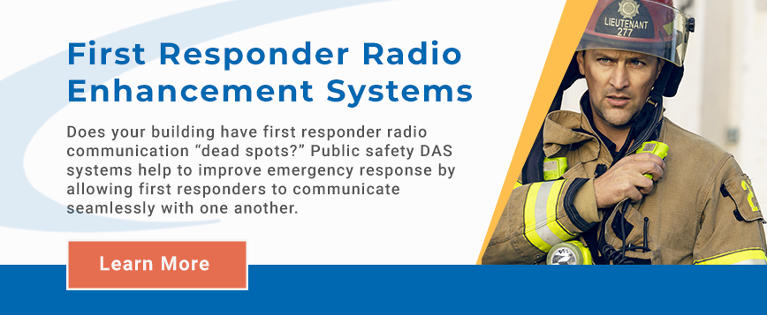Public safety distributed antenna systems (DAS) help first responders maintain constant radio contact with one another during emergencies. These systems are crucial for emergency response situations because of how clear communication impacts rescue efforts.
Why is constant communication a necessity in an emergency? How do first responders use DAS systems?
And, how does public safety DAS work?
Why DAS Communication Systems Are Crucial in an Emergency
Without a robust communications system to allow first responders to keep in touch and receive constant updates, preventable casualties may occur during an emergency. Building materials — such as steel, wood, concrete, and glass — can interfere with radio frequencies, including those used by emergency responders’ radios.
For example, as noted in a CBS News report from after the 9/11 terrorist attack on the World Trade Center, a “report by the federal commission investigating the Sept. 11 attacks found that rescuers were forced to make rapid-fire, life-and-death decisions based on poor communications, contributing to the World Trade Center death toll.”
Also, as stated in the CBS story, this wasn’t the first time that a lack of working communication systems had been an issue for first responders in the World Trade Center—a previous bombing attack in 1993 “exposed major flaws in emergency response plans for the twin towers. Stairways went black and public address systems failed. Firefighters’ radios lost their signal. It took ten hours to evacuate the towers in the 1993 attacks.”
This highlights how, without adequate communication systems, rescue efforts can be stalled, delaying potentially life-saving support when people most need it.
How Does Public Safety DAS Work?
A public safety distributed antenna system works fairly similar to a cellular enhancement DAS solution. These systems use a series of repeaters scattered throughout a building to pick up radio signals on emergency communication bands, and relay those signals throughout the building. In the majority of cases, emergency responders don’t actively use the system—they simply use their radios like normal, and the system seamlessly relays the communication for them.
The major difference between public safety and cellular enhancement DAS is that, instead of relaying cell phone signals throughout a building for everyone to use, public safety DAS solutions only work with emergency radio frequencies. With the proper public safety DAS installed, first responders in emergency situations can communicate more easily—which can help to save lives.
What Are the Requirements for Public Safety DAS?
Different states or jurisdictions within a state may have different emergency communication system standards—so public safety DAS solutions may be slightly different depending on these standards. So, it’s important to check with your local building code for specifics.
The most common requirements included in a public safety distributed antenna system guideline include:
- Explanations of who is responsible for public safety DAS costs (typically the building owner);
- A minimum signal strength limit;
- Application of the limit over a percentage of each floor;
- A specific level of reliability (power backups, water resistance, cable protection, etc.);
- A specified frequency band (or set of bands) for public safety communication;
- DAS system testing requirements and procedures;
- Ongoing monitoring and maintenance standards;
- Penalties for violations; and
- Provisions for waivers to any of the above requirements.
For example, according to the Florida Department of Management Service’s Law Enforcement Communications Plan, there are three sets of frequency bands that analog portable radio equipment for law enforcement officers can use (VHF High Band, UHF, and 800 MHz). Each of these frequency bands need to meet specific standards for:
- Band spacing (12.5 kHz for VHF and UHF bands, 25 kHz for the 800 MHz band);
- Frequency spread (24 MHz for VHF, 20 MHz for UHF, and 18 MHz for 800 MHz); and
- Power output (4 Watts for VHF High Band and UHF, 3 Watts for the 800 MHz band).
So, any public safety DAS system for Florida facilities will need to be able to accommodate these communication frequency bands.
Are you unsure if you need a public safety distributed antenna system in your building or do you need to have one installed to meet code requirements? Reach out to the Blue Wave team to get an expert assessment!
